Study an Entire Civilization
The world of the ancient Greeks and Romans stretched from Britain to the deserts of North Africa and from Spain to Afghanistan, encompassing the entire coastline of the Mediterranean and Black Seas.

The Roman Empire at its greatest extent. 3rd cent. C.E.
Ancient History
The Romans brought to the known world the common Hellenistic civilization which they inherited from the Greeks, which itself had spread through the Middle East through the conquests of Alexander the Great. The political order, city-planning, and infrastructure such as roads brought by the ‘Roman Peace’ (Pax Romana) fostered the rapid spread of political, artistic, and philosophical ideas. When the empire declined, in Late Antiquity, it bequeathed its rich philosophical and political heritage to Latin Medieval Christendom, Greek Byzantium, and the Islamic world.

Palmyra, Syria
Ancient Literature
Greek and Latin literature is incredibly rich. Most of the literary forms we know either had their origin in the classical world, or had ancient parallels: epic, drama, lyric poetry, love poetry, satire, the novel, etc.

Battle over the body of Patroclus, from Homer’s Iliad. National Archaeological Museum, Athens. Circa 530 B.C.E.
Mythology
What we think of a ‘Greek Mythology’ are the stories about the gods and heroes found in Greek and Roman literature that, for the Ancients, were an important part of their religious life. The Olympian gods were imagined by the ancients in striking and vivid ways as just like human beings, only deathless and more powerful than us, and beyond us in wisdom and insight into the machinery of the universe.
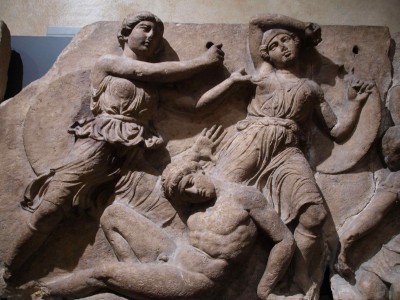
The battle of Heracles against Hippolyte and the Amazons. Frieze of the Temple of Bassae. British Museum, London. 420—400 B.C.E.
Art and Architecture
When we think of Greek and Roman art and architecture, we think of the symmetry and order, the perfect physique of the statue of a god or goddess, the incredible movement in Hellenistic sculpture, and the order and grandeur of Greek temples and Roman civic buildings. But, in addition to these aspects emphasised since the Renaissance, Ancient art includes the outlandish and grotesque, the ‘primitive’, and simple and moving images that give us insight into real people’s daily lives.
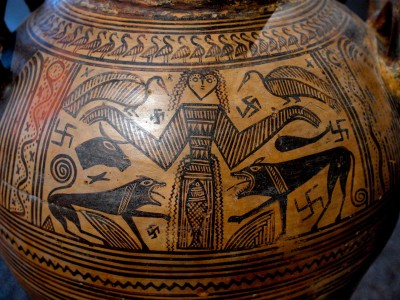
Mistress of the Animals, the great goddess of nature, flanked by lions, with dismembered bovine and birds in the background. National Archaeological Museum, Athens. 680—670 B.C.E.
Archaeology
Classical Archaeology is the study of the material remains of Ancient Greece and Rome. It ranges from the study of architectural remains, artistic works, and the implements of everyday life, from famous sites such as Troy, Mycenae, or Knossos, to Greek sites along the Ionian coast in modern-day Turkey, to Greek and Roman sites in Sicily, Italy, and as far afield as Africa, France, and Britain.

Frescoe in the Villa of the Mysteries, Pompeii, Italy. Buried by the eruption of Mt. Vesuvius, C.E. 79.
Ancient Philosophy, Rhetoric, and Political Theory
Classical Athens was the setting of intense discussions about the makeup of the cosmos, human nature, and how best to think and to speak, among philosophers such as Socrates, Plato, and Aristotle, and sophists and rhetoricians such as Protagoras and Isocrates. The Romans took what they found useful from the traditions of Platonism, Aristotelianism, and Stoicism, and added their own practical bent to it, to work out a theory and practice of politics suited for world government.
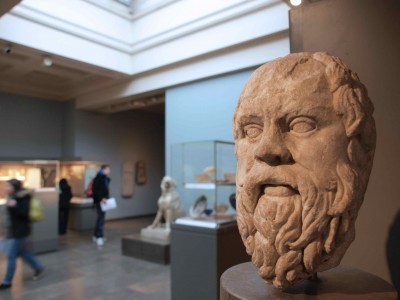
Socrates. British Museum, London. Roman copy of lost Greek original dating to 380—360 B.C.E.
Ancient Science
Our word ‘science’ expresses the Greek ἐπιστήμη (epistêmê) or Latin scientia, a knowledge of the orderly workings of nature. Ancient science was partly the same as ancient philosophy, and included inquiries into the basic makeup of the cosmos, from the revolutions of the heavenly spheres down to the four elements, the study of the physiology and behaviour of animals and plants, and pure mathematics, and extended to applied fields such as medicine and mechanics.
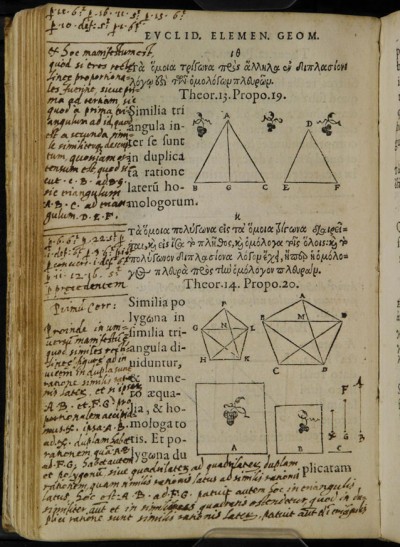
Euclid’s Elements of Geometry, in the original Greek with a Latin translation. Printed 1558. Manuscript annotations by Galileo Galilei. Biblioteca Nazionale di Firenze. (Image used under Creative Commons 3.0 License).
Greek and Latin
Carleton students can study the Ancient World without learning classical languages, but the experience is greatly enriched by learning Ancient Greek and/or Latin. Learning another culture’s language gives you invaluable insight into its patterns of thought. Unlike English, Greek is a fundamentally verb-based language, which gives it a rich fluidity and movement; Latin has a stark and spare beauty that comes from the fact that it has no word for ‘the’ or ‘a’, so that for example ‘a ship’ ‘the ship’ and ‘ship’ are all expressed by ‘navis’.
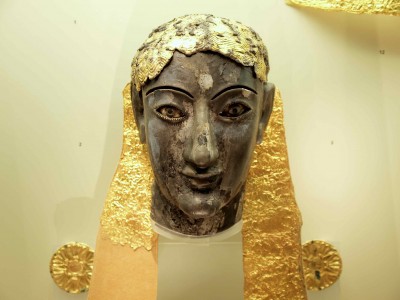
Apollo. Archaeological Museum in Delphi, Greece. 6th cent. B.C.E.
More about what you will study
| ← | About Greek and Roman Studies | Student Life | → |
